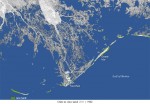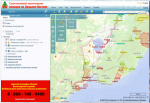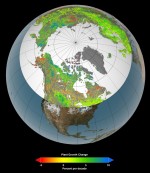Friday, April 12th, 2013
For scientists studying summer sea ice in the Arctic, it’s not a question of “if” there will be nearly ice-free summers, but “when.” And two scientists say that “when” is sooner than many thought — before 2050 and possibly within the next decade or two.
Tuesday, April 9th, 2013
Weather forecasters would love to be able to predict the severity of tornado outbreaks, giving those in their path potentially life-saving information. Now, using new experimental high-resolution forecast models, researchers have developed a method to help forecasters better predict the severity of tornado outbreaks. A report on this work by scientists at NOAA’s National Severe Storms

Saturday, April 6th, 2013
Every year, 25-35 square miles of land off the coast of Louisiana—an area larger than Manhattan–disappears into the water due to a combination of subsidence (soil settling) and global sea level rise. The maps above show how much land has been lost to the Gulf of Mexico in the past 80 years.

Saturday, April 6th, 2013
By the beginning of the 2013 fire hazardous season WWF Russia prepared an open interactive resource called “Satellite-based monitoring of fires at the Far East of Russia”. This service operates based on “Geomixer” technology, developed by ScanEx RDC.
Tuesday, March 12th, 2013
Budding innovators and entrepreneurs are being asked to contribute ideas that could help businesses improve their environmental performance, with the opportunity to win a slice of a £100,000 development prize fund. The GeoVation Challenge, run by mapping agency Ordnance Survey, is seeking ideas on how the use of geographic data can help British business improve
Monday, March 11th, 2013
Satellites map changes in Earth’s surface caused by earthquakes but never before have sound waves from a quake been sensed directly in space – until now. ESA’s hyper-sensitive GOCE gravity satellite has added yet another first to its list of successes.

Sunday, March 10th, 2013
Vegetation growth at Earth’s northern latitudes increasingly resembles lusher latitudes to the south, according to a NASA-funded study based on a 30-year record of land surface and newly improved satellite data sets.
Saturday, March 9th, 2013
A new NOAA study projects that heat-stress related labor capacity losses will double globally by 2050 with a warming climate. The impact will be felt the most by those who work outside or in hot environments, such as firefighters, bakery workers, farmers, construction workers, factory workers, and others who will be forced to slow down
Saturday, March 2nd, 2013
A new satellite that will detect the lightning inside storm clouds may lead to valuable improvements in tornado detection. The GOES-R satellite is currently being built with new technology that may help provide earlier warnings for severe weather. The national average is a 14-minute lead time to warn residents of a tornado, but NASA and
Thursday, February 21st, 2013
An alien or non-native species is an organism which humans have introduced –intentionally or accidentally -outside its previous range. It is deemed ‘invasive’ if it has negative effects on its surroundings, for example by outcompeting or predating on native species that have evolved without specific adaptations to cope with them. In such cases populations of